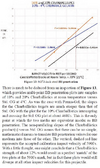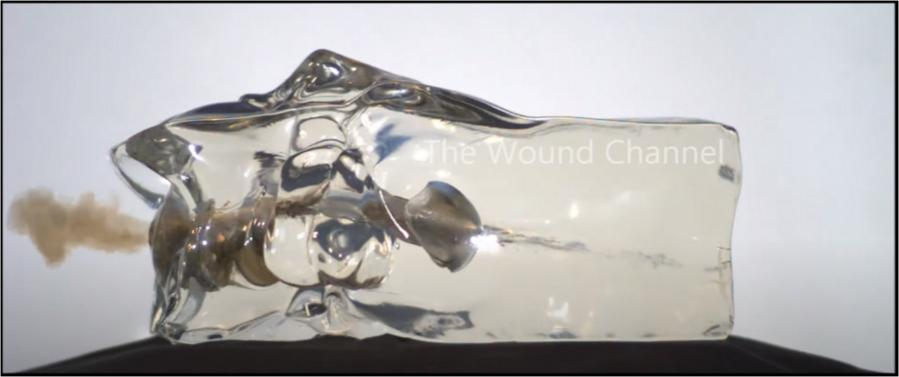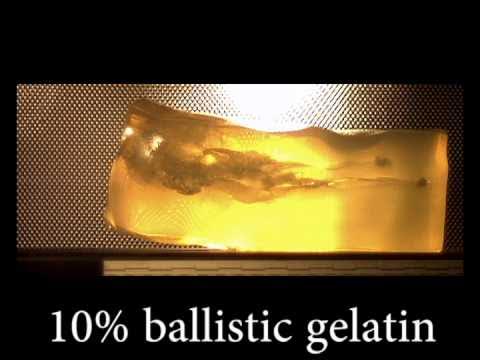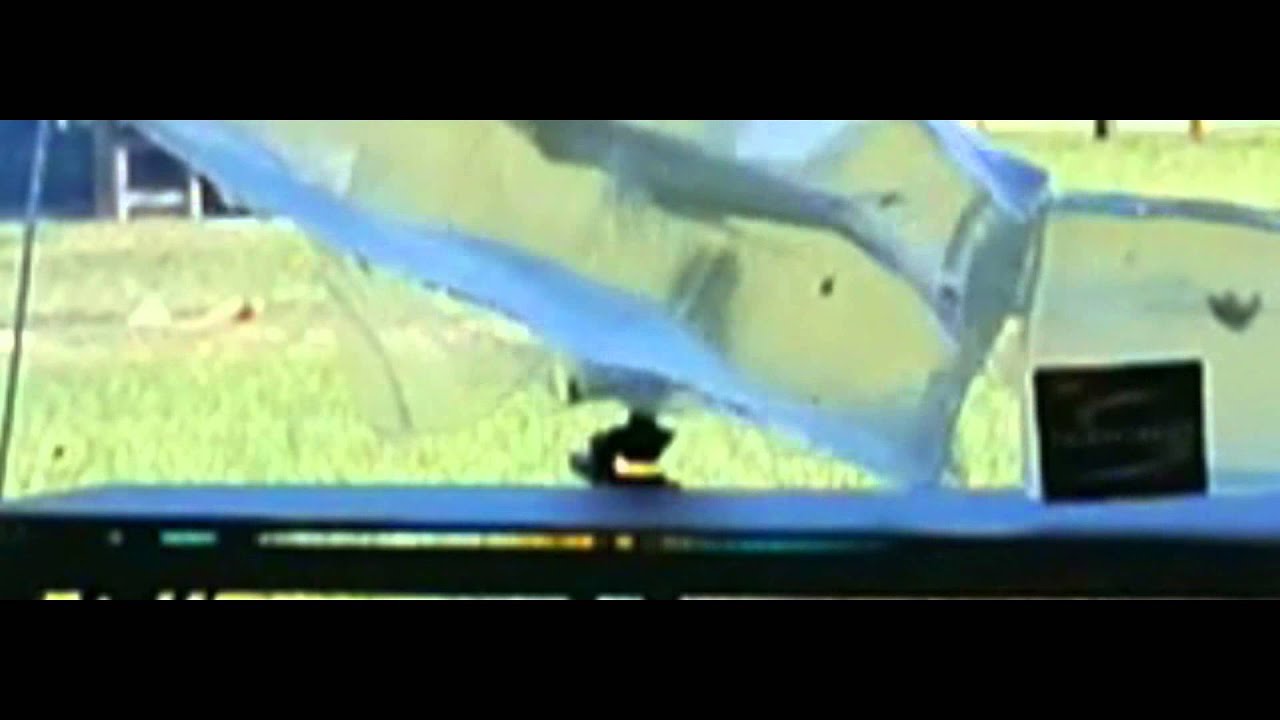The tests are more than conjecture. They provide concrete evidence. It may not be the evidence you like or want, but it is more than conjecture when we actually see the hollowpoint fail to expand. While I agree that Youtube ballistic testing is often riddled with ineffective procedures and awful analysis leading to non-sense conclusions or nothing at all but entertainment, we have far more evidence available to us nowadays than in any previous day. What's more, the supposed experts who could have the testing that you might deem valid have a history of coming to inconsistent or bad conclusions as evidenced by their flip-flopping and their own acknowledgement of failures that prompted the changes they've effected.
Nope. I am not in any position to ''deem valid'' any of the research or researchers that I have referenced, and neither are you.
Their professional credentials, acumen, and research stands on its own. You may not agree with it, but there it is.
While the LeHigh testing is certainly valid for its use of a valid test medium, all tests using the Clear Ballistics Gel product are invalid. Dismissing an entire comprehensive body of research without providing evidence that contradicts it does not damn the quality of the research; it's just an unsupported opinion that means nothing. Garbage in; garbage out.
The Clear Ballistics Gel
® product has been found by numerous independent sources—besides the IWBA—to be deficient in its ability to correctly represent the terminal ballistic performance (expansion, penetration depth, temporary and permanent cavities) of test bullets. Testing in the Clear Ballistics Gel product should never be used to select self-defense ammunition as it fails on every possible level to produce valid data.
Here is a small sample of the large body of available evidence (cited below)—
#1.) Clear Ballistics Gel®: High Speed Retarding Force Analysis of Paraffin-Based Alternative to Gelatin-based Testing of Lead-Free Pistol Bullets (researchgate.net) (Courtney, M., et al, 2017)
Snippet from source #1:
Earlier publications using high speed video retarding force analysis have quantified the energy loss during penetration and also the expected probability of incapacitation given a hit, P(I/H), for various loads [2, 4-5]. However, the reasonableness of that analysis depends on the penetration depths and retarding forces in Clear Ballistics Gel® being comparable with calibrated 10% ballistic gelatin. The significant differences between Clear Ballistics Gel®and calibrated 10% ballistic gelatin would render such estimates and comparisons misleading. As a result of the significant differences between Clear Ballistics Gel® and calibrated 10% ballistic gelatin, it is recommended that results from testing in Clear Ballistics Gel® not be used for testing and selecting of loads for duty use, self-defense, or hunting applications. Results from testing in Clear Ballistics Gel® might be used to identify promising candidates for further testing in calibrated 10% ballistic gelatin, which remains the best available standard for wound ballistics testing.
#2.) The use of gelatine in wound ballistics research | SpringerLink (Carr, DJ, et al, 2018)
Snippet from source #2:
Alternative synthetic materials have been used and reportedly produce similar results as gelatine without the need to condition at a particular temperature (e.g. PermaGel™, Clear Ballistics Gel®). Claimed advantages include the ability to melt and re-use these materials without detrimental effect to the physical and mechanical properties (within limits). However, literature has reported that these materials produce different DoP and damage when compared to gelatine blocks [21, 22]. Evidence of ageing after one re-melt has also been reported, and burning within the blocks (which is not observed in gelatine blocks) is observed post-testing due to the composition of the material [21, 23].
#3.) AFTE Journal Vol 52 No 2 (2020) | AFTE (Haag, Lucien, C., et al, 2020)
Snippet from source #3:
There is much to be deduced from an inspection of Figure 13, which provides multi-point BB penetration plots into samples of 10% and 20% Clear Ballistics Gel at room temperature versus Std. OG (ordnance gelatin) at 4°C. As was the case with Perma-Gel, the slopes for the Clear Ballistics targets are much steeper than that of Std. OG with the plot for the 10% Clear Ballistics intercepting and crossing the Std. OG plot at about 460fps. This is the only point at which the two media are equivalent insofar as BB penetration. The non-paralleling slopes of the Clear Ballistics product(s) versus Std. OG means that there can be no simple, mathematical means to translate BB penetration values for one medium into those of the other.

#4.) Comparing FBI ballistic gelatin with synthetic ballistic gelatin (police1.com) (Wood, Mike, Lt. Col. ret., 2020)
Snippet from source #4:
- The clear synthetic gelatin currently demonstrates a tendency to limit bullet expansion and increase bullet penetration, compared to FBI-standard, 10% calibrated organic gelatin. Based on our limited sample, this tendency seems to apply irrespective of bullet manufacturer, materials, design, construction, weight, pressure, or velocity. It seems that bullets penetrate significantly more in the clear synthetic, even when acceptable variations in organic gelatin penetration depth are accounted for.
- The clear synthetic gelatin currently does not appear to be a suitable substitute for FBI-standard, 10% calibrated organic gelatin if the bullets will be measured and evaluated according to FBI performance standards. Because the bullets we tested behaved so differently in the clear synthetic gelatin versus the 10% calibrated organic gelatin, it’s not appropriate to use the FBI standards ‒ which were designed to be applied to 10% calibrated organic gelatin – to measure bullet performance in the clear synthetic product.
In example, it’s inappropriate to measure and evaluate bullet penetration according to the FBI protocol (which rewards bullets that penetrate between 12” and 18” in 10% calibrated gelatin and penalizes those that fall outside this window) when bullets may routinely penetrate an extra 6” in the clear synthetic. If we did apply FBI standards to the clear synthetic, we might “pass” a bullet that normally fails the FBI protocol because it doesn’t penetrate deeply enough. Conversely, we might “fail” a bullet because it over penetrates in the clear synthetic, even when it normally passes the FBI protocol because by remaining within FBI penetration limits.
- There is no apparent “conversion” between data derived from 10% organic gelatin and the current version of the clear synthetic. Unfortunately, our limited test doesn’t indicate a conversion “shortcut” is likely. It would be convenient if we could develop a conversion factor that would equate the organic gelatin and clear synthetic gelatin, but our data indicate that bullet performance is too variable in these mediums to develop a universal “rule of thumb.” Perhaps a skilled mathematician could derive a constant from a more complete sample, but we’re not seeing one lurking in the data.
#5.) Clear Ballistics VS 10% gelatin - YouTube (Brassfetcher, John Ervin, Mech Eng., 2014)
We compared the terminal ballistics performance of various pistol JHP and shotgun ammunition in both 10% ballistic gelatin and Clear Ballistics gelatin. The...

www.youtube.com
From the linked Brassfetcher video:
The Clear Ballistics Gel product fails to shear-validate correctly meaning that it cannot and does not accurately represent the viscous drag component that dominates the non-cavitation regime of bullet penetration. This deficiency alone excludes the Clear Ballistics Gel product from use as a valid soft tissue simulant.
In order to reproduce the dynamic pressure that initiates and drives projectile expansion in human soft tissues, a valid tissue simulant must possess an internal sonic velocity (c), mass density (ρ), and bulk modulus (K) that is as close to possible as that of human soft tissues (viscera, skeletal muscle, etc.).
According to Mast, T. D., ''
Empirical Relationships Between Acoustic Parameters in Human Soft Tissues'', Acoustical Society of America (2000), the composite mass density of human soft tissues is ρ = 1.043 g/cm³ and the average internal sonic velocity of human soft tissues is given as c = 1,561 m/s. Using the Newton-LaPlace formula, these two values can be used to provide a measure of the average compressibility (that is, the bulk modulus) of human soft tissue as K = 2.541 GPa. A valid tissue simulant must closely reproduce these quantitative physical properties in order to correctly drive projectile expansion and to accurately represent maximum terminal penetration depth.
The respective mass density (ρ), internal sonic velocity (c), and bulk moduli (K) of 10% Type 250-A ordnance gelatin and water are very close to that of the composite human soft tissue profile—
Human soft tissues (composite): ρ = 1.043 g/cm³, c = 1,561 m/s, and K = 2.541 MPa
10% Type 250-A ordnance gelatin: ρ = 1.040±0.002 g/cm³, c = 1,513 m/s, and K = 2.381 MPa
Water: ρ = 0.999972±0.010 g/cm³, c = 1,497 m/s, and K = 2.241 MPa
In comparison, as determined under FTIR analysis, Clear Ballistics Gel is composed of Versa-Gel, a SEBS (Styrene-Ethylene/Butylene-Styrene) co-polymer, that is plasticized with a transparent paraffinic processing oil (in this specific case, Paralux-701).
The physical properties of the CBG product differ significantly from those of composite human soft tissues, 10% Type 250-A ordnance gelatin, and water:
Clear Ballistics Gel: ρ = 0.824 g/cm³, c = 1,434 m/s, and K = 1.694 MPa
A strict technical approach to establishing the dynamic similitude of proposed tissue simulants to human soft tissues requires that their respective EOS (equations of state) match in order to correctly represent nonlinear impact responses to projectile strikes. For fluids and soft solids (that are composed primarily of water), EOS is expressed as the Hugoniot shock velocity (U). Hugoniot shock velocity is the velocity of the wave that is created by, and preceeds, a projectile as it passes through a substance. Hugoniot shock velocity (U) is a function of the material's mass density (ρ), a first-order derivative of the material's bulk modulus (K'), the material's internal sonic velocity (c) and the particle velocity (v) most usually expressed in the form of a linear function; U = c + K'v
Test mediums that have coinciding EOSs (equivalent or nearly equivalent intercepts and slopes) are taken to be dynamically equivalent to one another.
For the materials currently under discussion, the respective EOS are:
Human soft tissues (composite): U = 1.561 + 2.160v
10% Type 250-A ordnance gelatin: U = 1.513 + 2.024v
Water: U = 1.497 + 1.901v
Clear Ballistics Gel: U = 1.434 + 1.444v
Since the intercept and slope of the Clear Ballistics Gel EOS differs greatly from the EOS of the two proven soft tissue simulants and the human soft tissue composite profile, any test data obtained in the Clear Ballistics Gel product will deviate significantly from them at both extrema along any terminal penetration curve. The CBG EOS indicates that its physical response to impacts diverges significantly from the other three mediums by a wide margin.
There are only two valid human soft tissue simulants at present; 10% Type 250-A ordnance gelatin and water.
The Clear Ballistics Gel product also introduces three other confounding factors that detract from its ability to correctly simulate human soft tissues.
First, projectiles tested in the Clear Ballistics Gel product tend to exhibit disproportionate amounts of terminal rebound. All projectiles rebound in both human soft tissue and 10% ordnance gelatin, but only at very small scales on the order of larger fractions of an inch. In water, because it does not support shear, no rebound occurs at all. However, in the Clear Ballistics Gel product, projectiles can, and often do, exhibit tremendous terminal rebound sometimes as much as 25% - 30% of the entire permanent channel length confounding test data in the process.
The 'rebound' phenomenon is demonstrated in this video by ShootingTheBull410:
The Glock 21, shooting .45 ACP, is a serious, potent handgun. It's a full-size "duty weapon", with a 4.6" barrel, and I shot top-of-the-line Federal Premium...

www.youtube.com
At 8 seconds in the high frame-rate video, the projectile tested in the Clear Ballistics Gel product can be observed at its maximum terminal penetration depth (≈18 inches)
Shortly thereafter in the high frame-rate video (about 9 seconds), the projectile can be observed having rebounded approximately 4½ inches rearward from its maximum terminal penetration depth of 18 inches, or about 25% of its maximum depth. The rheological properties of the Clear Ballistics Gel differ greatly from soft tissue and the proven soft tissue simulants causing the temporary cavity to remain near its maximum for an extended period of time allowing the projectile to oscillate within the cavity coming to rest only when the temporary cavity finally collapses trapping the projectile at some random location along the length of the permanent cavity. This unusual behavior obviously introduces additional significant error into the test result.
Second, the Clear Ballistics Gel product commonly exhibits behavior during penetration events that is never seen in either of the two proven soft tissue simulants or in human soft tissues. In the high frame-rate videography by The Wound Channel:
Enjoy the videos and music you love, upload original content, and share it all with friends, family, and the world on YouTube.

www.youtube.com
—the collapse of the temporary cavity evidenced in the attached video, causes the volatiles from the Paralux-701 paraffinic processing oil used in the manufacture of the Clear Ballistics Gel product to auto-ignite under adiabatic compression (also known as ''dieseling'').
This effect is commonly attributed by those lacking technical expertise in the field to sonoluminescence, but sonoluminescence is not a process that involves combustion. The ejection of the sooty, black smoky residue from the projectile's point of entry in the Clear Ballistics Gel block is indicative of an exothermic process—that is, combustion—involving the volatiles liberated from the Paralux-701 in the Clear Ballistics Gel during the low-pressure phase of cavity evolution cycle resulting in the incomplete combustion and ejection of the heated combustion products (as unburnt carbon in the smoke) from the front of the CBG block (as seen below).

The manufacturer of Paralux-701 lists its auto-ignition temperature as 358°F. This means that the temperature inside the collapsing Clear Ballistics Gel's temporary cavity is at least 358°F and considerably greater than that after auto-ignition of the Paralux-701 vapors occurs. This effect does not occur in human bodies that are struck and penetrated by conventional (non-explosive, non-incendiary, etc.) munitions and serves as further evidence that the Clear Ballistics Gel product is not a correct/sufficient representative analog for human soft tissues of any sort.
Third, the manufacturer of Clear Ballistics Gel routinely alters the composition of its product without notice or explanation relegating test 'data' obtained in different lots incomparable to one another. There is no way to account or correct for the variance that is introduced by this practice making the product even less useful than it was to begin with.
There are better, much more valid options for the amateurs who wish to propagate legitimate factual material for their intended audiences.
The first option is to produce valid test data using properly prepared 10% nominal concentration Type 250-A ordnance gelatin, which is a valid soft tissue simulant. It's actually easy to do. It just requires a little more care and attentin to detail, but the data produced is valid whereas ''data'' taken from the use of the Clear Ballistics product is not.
The second, equally viable, option is to conduct terminal ballistic testing in water, which is also a valid soft tissue simulant. It is an inexpensive yet very accurate way to obtain valid test data.
Since water doesn't support shear, maximum terminal penetration depths are easily computed using any of the five bullet penetration equations in existence. The Q-Model (2012), WTI (1995), UTSI (1990) and US Army BRL (1973) bullet penetration equations are Poncelet forms all of which are strongly correlated (respectively) against thousands ordnance gelatin test data across a wide spectrum of calibers, velocities, and sectional density. The
m-THOR algorithm (2014), also highly correlated against 900+ ordnance gelatin data, is a heavily modified 1950s-era armor SLV (Survivability, Lethality, Vulnerability) equation that can also be used to predict maximum terminal penetration depth and wound volume and mass with a high degree of accuracy and confidence.
Dr. Fackler's conversion factor for the conversion of penetration depth in water to equivalent maximum terminal penetration depth in 10% ordnance gelatin, is a simple linear conversion value of 1.5x (IWBA Fall 2001 5:2, p.21) that—while certainly well intentioned—introduces significant error into any prediction and estimation of equivalent penetration depth in 10% ordnance gelatin since it treats the penetration process as a simple linear function. It is not.
Because of the significant differences in physical/quantitative material properties between the Clear Ballistics Gel product, the two proven soft tissue simulants, and human soft tissues, the CBG product invariably produces significantly less expansion and concurrently much greater maximum terminal penetration depths than seen in either human soft tissue or human soft tissue simulants. Anyone who is serious about legitimately evaluating the performance of their self-defense ammunition should avoid the use of the CBG product since it is wholly incapable of rendering valid test data that reproduces the terminal ballistic performance in human soft tissues. If we desire the accurate representation of terminal ballistic performance in human soft tissues, a valid tissue simulant is required. Otherwise, we're just wasting our time (and our money) with an inferior product (Clear Ballistics Gel).
Once again, there are only two valid human soft tissue simulants at present; 10% Type 250-A ordnance gelatin and water.
Like it or not, tests relying upon the Clear Ballistics Gel product are fundamentally flawed for the above reasons and rise only to the level of ''amateurish entertainment''. They are a waste of time, money, and effort.
Test results obtained in the Clear Ballistics Gel product are not valid and the ''data'' obtained from such a dubious testing protocol should be avoided at all costs when choosing self-defense ammunition. It's nothing more than cheap entertainment.




